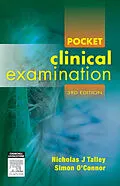Pocket Clinical Examination is an introduction to history taking and the examination of patients. It has step by step instructions for the junior medical officer working on the ward for the first time. It aims to provide a solid foundation from which students can develop their own systematic approaches. Details of the mechanisms of symptoms and signs, and comprehensive lists of differential diagnosis are not included but may be found in the larger text Clinical Examination. There is a section on writing and presenting the history and physical examination. PCE provides an introduction to physical examination and a place where students can go for revision before examining patients. - Excellent line drawings closely keyed to the text - Concise approach - Examination of the major systems summarised - New emphasis on evidence-based medicine - New chapters added eg., coverage of advanced history taking, assessment of the acutely ill patient, introduction to examination of the skin - Key anatomical drawings assist students understand the relevant clinical anatomy of regions of the body being examined - Hints on how to approach OSCEs
Autorentext
Nicholas J Talley, MD (NSW), PhD (Syd), MMedSci (Clin Epi)(Newc.), FAHMS, FRACP, FAFPHM, FRCP (Lond. & Edin.), FACP , Pro Vice-Chancellor, Global Research, University of Newcastle, Australia Professor of Medicine, Faculty of Health and Medicine, University of Newcastle, Australia President, Royal Australasian College of Physicians Chair-Elect, Committee of Presidents of Medical Colleges (CPMC) Hon. Treasurer, Australian Academy of Health and Medical Sciences Senior Staff Specialist, John Hunter Hospital, Newcastle, Australia Adjunct Professor and Consultant, Mayo Clinic, Rochester, MN, USA Adjunct Professor, University of North Carolina, NC, USA Foreign Guest Professor, Karolinska Institutet, Stockholm, Sweden
Inhalt
Foreword
Preface
Acknowledgments
Chapter 1: Taking the history
Chapter 2: Advanced history taking
Chapter 3: Beginning the examination
Chapter 4: The heart
Chapter 5: The chest
Chapter 6: The abdomen
Chapter 7: The nervous system
Chapter 8: The eyes, and ears nose and throat
Chapter 9: The thyroid and endocrine system
Chapter 10: The breasts
Chapter 11: The joints
Chapter 12: The skin
Chapter 13: Assessment of the geriatric patient
Chapter 14: The acutely ill patient
Chapter 15: Examining the systems of the body
Chapter 16: Writing and presenting the history and
physical examination
OSCEs
Final remarks
Further reading
INDEX
